Indirect Tax Assignment (Solution)
VerifiedAdded on 2020/12/23
|14
|3988
|90
AI Summary
Contribute Materials
Your contribution can guide someone’s learning journey. Share your
documents today.
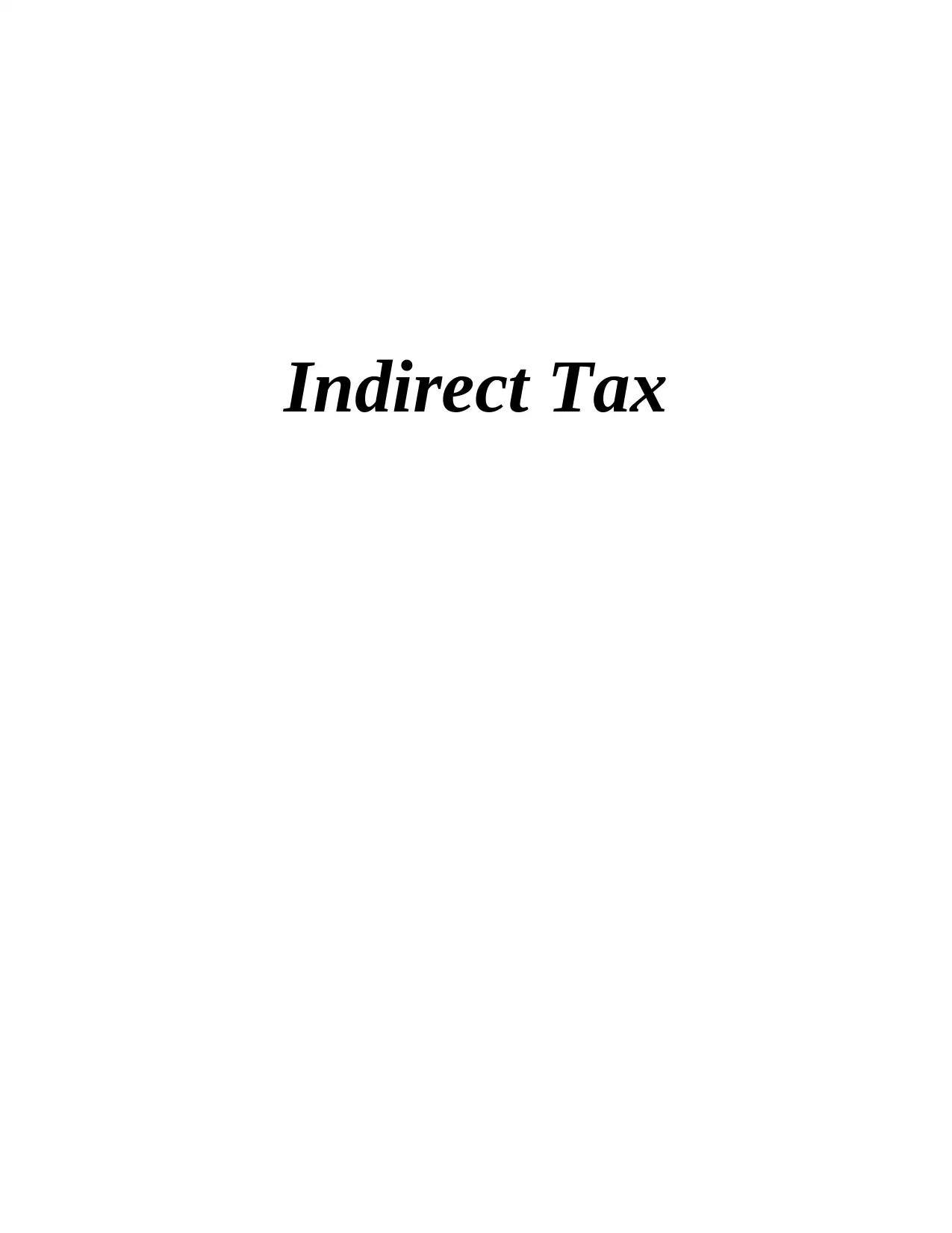
Indirect Tax
Secure Best Marks with AI Grader
Need help grading? Try our AI Grader for instant feedback on your assignments.
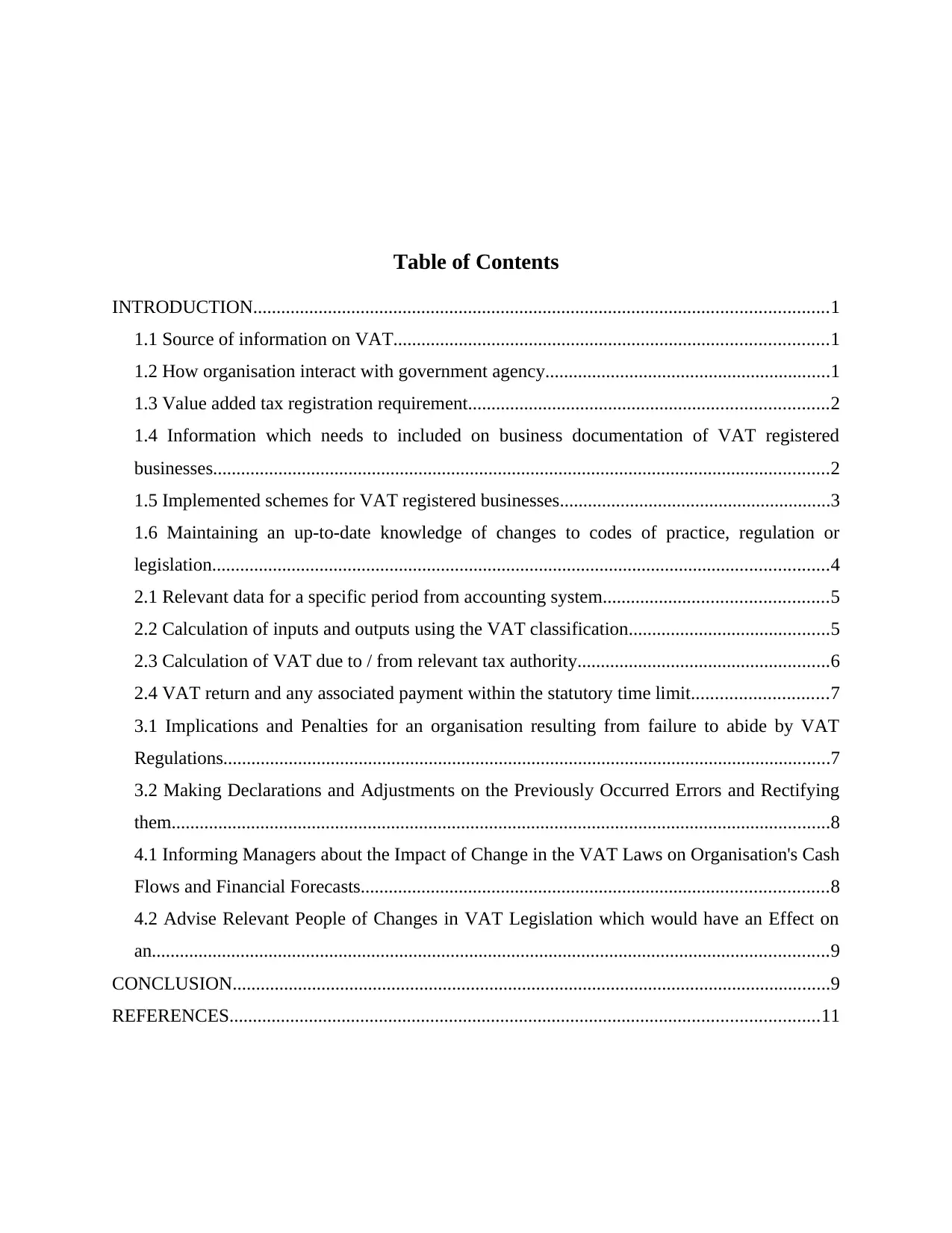
Table of Contents
INTRODUCTION...........................................................................................................................1
1.1 Source of information on VAT.............................................................................................1
1.2 How organisation interact with government agency.............................................................1
1.3 Value added tax registration requirement.............................................................................2
1.4 Information which needs to included on business documentation of VAT registered
businesses....................................................................................................................................2
1.5 Implemented schemes for VAT registered businesses..........................................................3
1.6 Maintaining an up-to-date knowledge of changes to codes of practice, regulation or
legislation....................................................................................................................................4
2.1 Relevant data for a specific period from accounting system................................................5
2.2 Calculation of inputs and outputs using the VAT classification...........................................5
2.3 Calculation of VAT due to / from relevant tax authority......................................................6
2.4 VAT return and any associated payment within the statutory time limit.............................7
3.1 Implications and Penalties for an organisation resulting from failure to abide by VAT
Regulations..................................................................................................................................7
3.2 Making Declarations and Adjustments on the Previously Occurred Errors and Rectifying
them.............................................................................................................................................8
4.1 Informing Managers about the Impact of Change in the VAT Laws on Organisation's Cash
Flows and Financial Forecasts....................................................................................................8
4.2 Advise Relevant People of Changes in VAT Legislation which would have an Effect on
an.................................................................................................................................................9
CONCLUSION................................................................................................................................9
REFERENCES..............................................................................................................................11
INTRODUCTION...........................................................................................................................1
1.1 Source of information on VAT.............................................................................................1
1.2 How organisation interact with government agency.............................................................1
1.3 Value added tax registration requirement.............................................................................2
1.4 Information which needs to included on business documentation of VAT registered
businesses....................................................................................................................................2
1.5 Implemented schemes for VAT registered businesses..........................................................3
1.6 Maintaining an up-to-date knowledge of changes to codes of practice, regulation or
legislation....................................................................................................................................4
2.1 Relevant data for a specific period from accounting system................................................5
2.2 Calculation of inputs and outputs using the VAT classification...........................................5
2.3 Calculation of VAT due to / from relevant tax authority......................................................6
2.4 VAT return and any associated payment within the statutory time limit.............................7
3.1 Implications and Penalties for an organisation resulting from failure to abide by VAT
Regulations..................................................................................................................................7
3.2 Making Declarations and Adjustments on the Previously Occurred Errors and Rectifying
them.............................................................................................................................................8
4.1 Informing Managers about the Impact of Change in the VAT Laws on Organisation's Cash
Flows and Financial Forecasts....................................................................................................8
4.2 Advise Relevant People of Changes in VAT Legislation which would have an Effect on
an.................................................................................................................................................9
CONCLUSION................................................................................................................................9
REFERENCES..............................................................................................................................11

INTRODUCTION
Indirect tax is a source of revenues for the government from the producer or retailer. This
amount is passed on consumers as part of their purchasing goods and services. Basically there
are two types of taxes which is levied on consumers direct and indirect tax. Direct tax includes
income tax and indirect tax includes sales tax, custom duties on import, excise duty on
production and value added tax (VAT). The main aim of this report is to understand various
VAT regulations. Apart from this the report discuss about accurate value added tax returns
within a given time period. The different penalties on value added tax and adjustments for
previous errors is being discussed in this report. There can great impact of indirect tax on cash
flows and financial forecasts of an organisation which is also discussed in this report.
1.1 Source of information on VAT
Value added tax is an indirect tax which is implied by the government on consumption of
goods and services by end consumers. The tax is levied on producer or retailer and than they
charge it from customers in order to pay to the government. This is a liability for retailer and
producers which is imposed by government (Littlewood, Murphy and Wang, 2013). This tax is
not applicable on all cities however some cities are exempted from this tax. The VAT payable by
a person is calculated by deducting inputs used for production of goods and services from cost of
products. There different sources for getting VAT information but reliable information can be
availed through federal government sites. Apart from this, HM revenue and customs portal
which is liable for collecting tax across UK. The different sources are discussed as below:
HMRC VAT – Traders registered for VAT purposes with HMRC
HMRC PAYE – Employers operating a PAYE scheme registered with HMRC
Companies house – Incorporated businesses registered at companies house
These are sources through which one can avail the information regarding VAT and its
compliances and can get benefit out of this.
1.2 How organisation interact with government agency
There are various government departments which circulate the laws and legislation for
organisations according to their nature. The organisations have to comply with these laws in
order to maintain their business in smooth way. While comply with these laws, organisations
faces various complication which can be solved by the government agencies. For example
1
Indirect tax is a source of revenues for the government from the producer or retailer. This
amount is passed on consumers as part of their purchasing goods and services. Basically there
are two types of taxes which is levied on consumers direct and indirect tax. Direct tax includes
income tax and indirect tax includes sales tax, custom duties on import, excise duty on
production and value added tax (VAT). The main aim of this report is to understand various
VAT regulations. Apart from this the report discuss about accurate value added tax returns
within a given time period. The different penalties on value added tax and adjustments for
previous errors is being discussed in this report. There can great impact of indirect tax on cash
flows and financial forecasts of an organisation which is also discussed in this report.
1.1 Source of information on VAT
Value added tax is an indirect tax which is implied by the government on consumption of
goods and services by end consumers. The tax is levied on producer or retailer and than they
charge it from customers in order to pay to the government. This is a liability for retailer and
producers which is imposed by government (Littlewood, Murphy and Wang, 2013). This tax is
not applicable on all cities however some cities are exempted from this tax. The VAT payable by
a person is calculated by deducting inputs used for production of goods and services from cost of
products. There different sources for getting VAT information but reliable information can be
availed through federal government sites. Apart from this, HM revenue and customs portal
which is liable for collecting tax across UK. The different sources are discussed as below:
HMRC VAT – Traders registered for VAT purposes with HMRC
HMRC PAYE – Employers operating a PAYE scheme registered with HMRC
Companies house – Incorporated businesses registered at companies house
These are sources through which one can avail the information regarding VAT and its
compliances and can get benefit out of this.
1.2 How organisation interact with government agency
There are various government departments which circulate the laws and legislation for
organisations according to their nature. The organisations have to comply with these laws in
order to maintain their business in smooth way. While comply with these laws, organisations
faces various complication which can be solved by the government agencies. For example
1
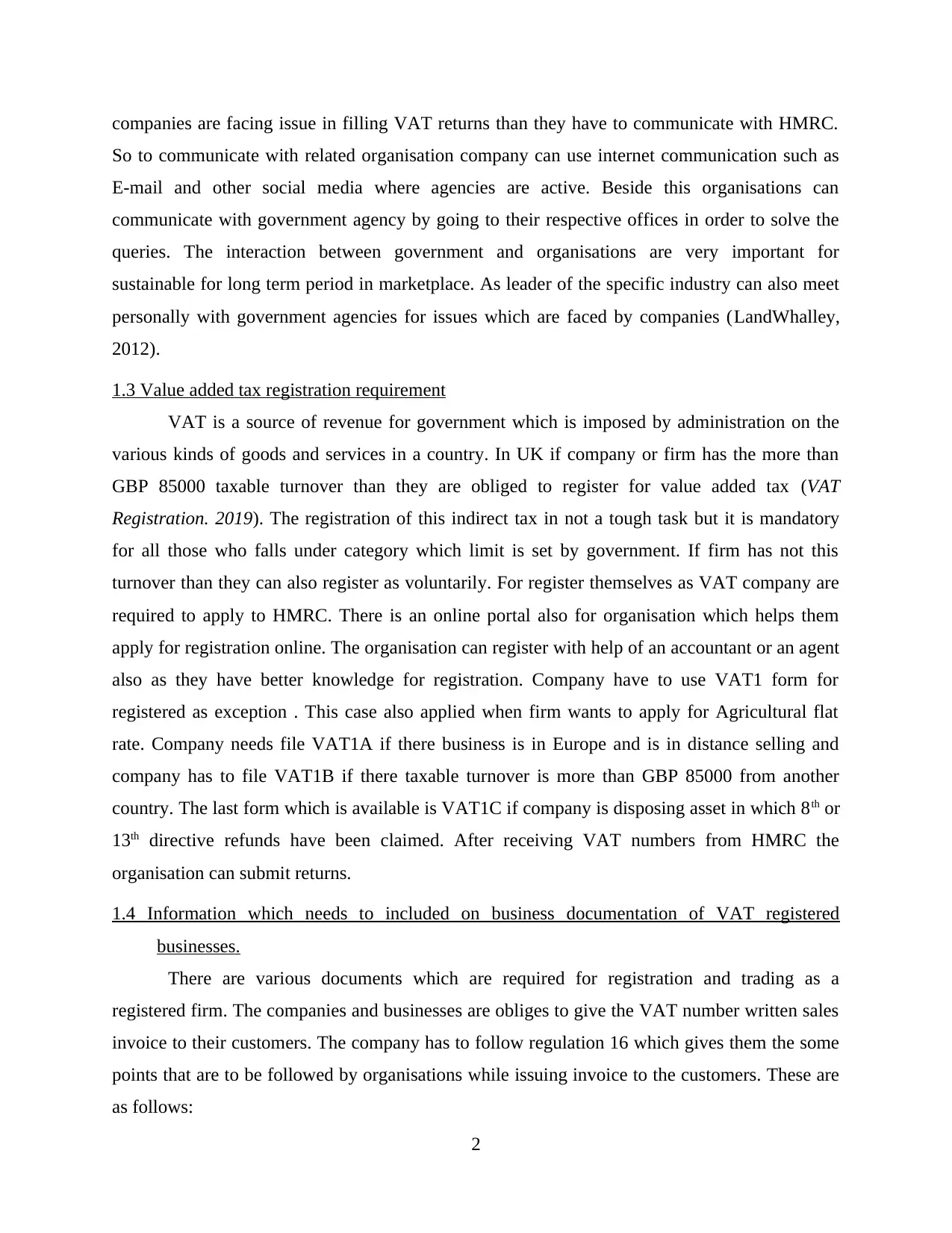
companies are facing issue in filling VAT returns than they have to communicate with HMRC.
So to communicate with related organisation company can use internet communication such as
E-mail and other social media where agencies are active. Beside this organisations can
communicate with government agency by going to their respective offices in order to solve the
queries. The interaction between government and organisations are very important for
sustainable for long term period in marketplace. As leader of the specific industry can also meet
personally with government agencies for issues which are faced by companies (LandWhalley,
2012).
1.3 Value added tax registration requirement
VAT is a source of revenue for government which is imposed by administration on the
various kinds of goods and services in a country. In UK if company or firm has the more than
GBP 85000 taxable turnover than they are obliged to register for value added tax (VAT
Registration. 2019). The registration of this indirect tax in not a tough task but it is mandatory
for all those who falls under category which limit is set by government. If firm has not this
turnover than they can also register as voluntarily. For register themselves as VAT company are
required to apply to HMRC. There is an online portal also for organisation which helps them
apply for registration online. The organisation can register with help of an accountant or an agent
also as they have better knowledge for registration. Company have to use VAT1 form for
registered as exception . This case also applied when firm wants to apply for Agricultural flat
rate. Company needs file VAT1A if there business is in Europe and is in distance selling and
company has to file VAT1B if there taxable turnover is more than GBP 85000 from another
country. The last form which is available is VAT1C if company is disposing asset in which 8th or
13th directive refunds have been claimed. After receiving VAT numbers from HMRC the
organisation can submit returns.
1.4 Information which needs to included on business documentation of VAT registered
businesses.
There are various documents which are required for registration and trading as a
registered firm. The companies and businesses are obliges to give the VAT number written sales
invoice to their customers. The company has to follow regulation 16 which gives them the some
points that are to be followed by organisations while issuing invoice to the customers. These are
as follows:
2
So to communicate with related organisation company can use internet communication such as
E-mail and other social media where agencies are active. Beside this organisations can
communicate with government agency by going to their respective offices in order to solve the
queries. The interaction between government and organisations are very important for
sustainable for long term period in marketplace. As leader of the specific industry can also meet
personally with government agencies for issues which are faced by companies (LandWhalley,
2012).
1.3 Value added tax registration requirement
VAT is a source of revenue for government which is imposed by administration on the
various kinds of goods and services in a country. In UK if company or firm has the more than
GBP 85000 taxable turnover than they are obliged to register for value added tax (VAT
Registration. 2019). The registration of this indirect tax in not a tough task but it is mandatory
for all those who falls under category which limit is set by government. If firm has not this
turnover than they can also register as voluntarily. For register themselves as VAT company are
required to apply to HMRC. There is an online portal also for organisation which helps them
apply for registration online. The organisation can register with help of an accountant or an agent
also as they have better knowledge for registration. Company have to use VAT1 form for
registered as exception . This case also applied when firm wants to apply for Agricultural flat
rate. Company needs file VAT1A if there business is in Europe and is in distance selling and
company has to file VAT1B if there taxable turnover is more than GBP 85000 from another
country. The last form which is available is VAT1C if company is disposing asset in which 8th or
13th directive refunds have been claimed. After receiving VAT numbers from HMRC the
organisation can submit returns.
1.4 Information which needs to included on business documentation of VAT registered
businesses.
There are various documents which are required for registration and trading as a
registered firm. The companies and businesses are obliges to give the VAT number written sales
invoice to their customers. The company has to follow regulation 16 which gives them the some
points that are to be followed by organisations while issuing invoice to the customers. These are
as follows:
2
Secure Best Marks with AI Grader
Need help grading? Try our AI Grader for instant feedback on your assignments.
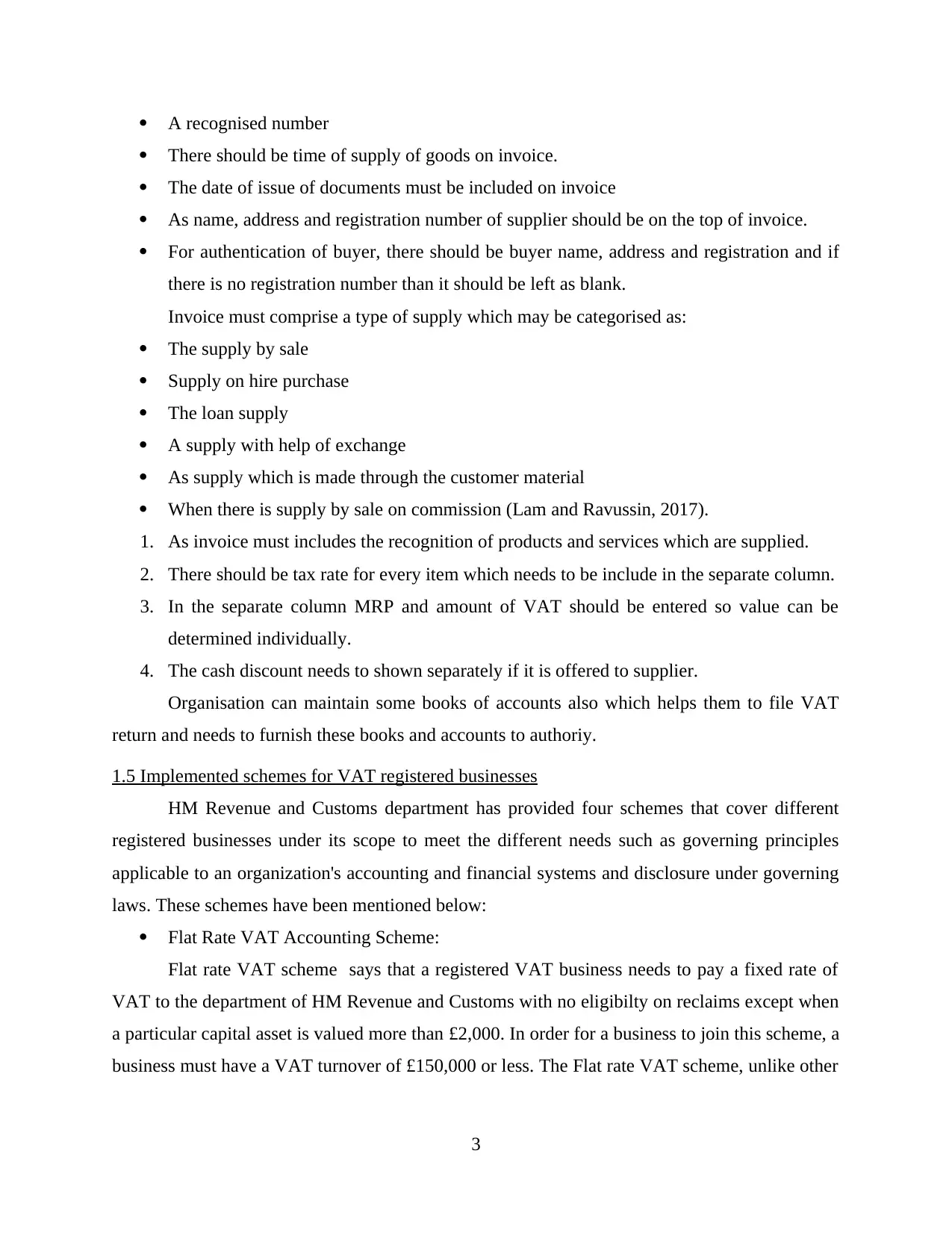
A recognised number
There should be time of supply of goods on invoice.
The date of issue of documents must be included on invoice
As name, address and registration number of supplier should be on the top of invoice.
For authentication of buyer, there should be buyer name, address and registration and if
there is no registration number than it should be left as blank.
Invoice must comprise a type of supply which may be categorised as:
The supply by sale
Supply on hire purchase
The loan supply
A supply with help of exchange
As supply which is made through the customer material
When there is supply by sale on commission (Lam and Ravussin, 2017).
1. As invoice must includes the recognition of products and services which are supplied.
2. There should be tax rate for every item which needs to be include in the separate column.
3. In the separate column MRP and amount of VAT should be entered so value can be
determined individually.
4. The cash discount needs to shown separately if it is offered to supplier.
Organisation can maintain some books of accounts also which helps them to file VAT
return and needs to furnish these books and accounts to authoriy.
1.5 Implemented schemes for VAT registered businesses
HM Revenue and Customs department has provided four schemes that cover different
registered businesses under its scope to meet the different needs such as governing principles
applicable to an organization's accounting and financial systems and disclosure under governing
laws. These schemes have been mentioned below:
Flat Rate VAT Accounting Scheme:
Flat rate VAT scheme says that a registered VAT business needs to pay a fixed rate of
VAT to the department of HM Revenue and Customs with no eligibilty on reclaims except when
a particular capital asset is valued more than £2,000. In order for a business to join this scheme, a
business must have a VAT turnover of £150,000 or less. The Flat rate VAT scheme, unlike other
3
There should be time of supply of goods on invoice.
The date of issue of documents must be included on invoice
As name, address and registration number of supplier should be on the top of invoice.
For authentication of buyer, there should be buyer name, address and registration and if
there is no registration number than it should be left as blank.
Invoice must comprise a type of supply which may be categorised as:
The supply by sale
Supply on hire purchase
The loan supply
A supply with help of exchange
As supply which is made through the customer material
When there is supply by sale on commission (Lam and Ravussin, 2017).
1. As invoice must includes the recognition of products and services which are supplied.
2. There should be tax rate for every item which needs to be include in the separate column.
3. In the separate column MRP and amount of VAT should be entered so value can be
determined individually.
4. The cash discount needs to shown separately if it is offered to supplier.
Organisation can maintain some books of accounts also which helps them to file VAT
return and needs to furnish these books and accounts to authoriy.
1.5 Implemented schemes for VAT registered businesses
HM Revenue and Customs department has provided four schemes that cover different
registered businesses under its scope to meet the different needs such as governing principles
applicable to an organization's accounting and financial systems and disclosure under governing
laws. These schemes have been mentioned below:
Flat Rate VAT Accounting Scheme:
Flat rate VAT scheme says that a registered VAT business needs to pay a fixed rate of
VAT to the department of HM Revenue and Customs with no eligibilty on reclaims except when
a particular capital asset is valued more than £2,000. In order for a business to join this scheme, a
business must have a VAT turnover of £150,000 or less. The Flat rate VAT scheme, unlike other
3

schemes, cannot be combined with other applicable schemes to avail multiple benefits by the
organisations.
VAT Cash Accounting Scheme:
VAT Cash Accounting Scheme demands that the taxable person needs to pay the
difference of purchase and sale invoices to the tax authorities as their VAT returns in a given
accounting period. This is generally applicable on firms that have a VAT taxable turnover of
£1.35 million or less. To avail benefits under multiple sections, this scheme can be clubbed with
accounting or retail and margin schemes accordingly (Kenyon, Langley and Paquin, 2012).
Annual Accounting Scheme:
Annual Accounting scheme requires a registered VAT business to pay returns on three
quarterly basis to the department of HM Revenue and Customs. Through this scheme, advance
VAT payments can be made and are eligible for a refund in case of any overpayment of bill. It is
not suitable for a business that reclaims regularly on its filings.
Retail and Margin Scheme:
Retail and Margin Schemes are organisation specific schemes that can be clubbed with
Cash accounting and Annual Accounting schemes to avail multiple benefits by organisations.
1.6 Maintaining an up-to-date knowledge of changes to codes of practice, regulation or
legislation
The taxable persons are liable to pay their due amounts within statutory time limits that
are in line with the codes, rules, regulations or legislations in effect. Hence, it is important for a
business or individual to maintain an up-to-date knowledge of any changes being made in these
areas. Any kind of lack or error discovered in the VAT returns due to negligence or deliberate
dismissal of invoices from tax filing can prove to be harmful to the reputation as well as they
may attract heavy penalties and interests from the tax authorities ranging between 15% to 100%
of amount due (Keen, 2013).
For instance, if an organisation does not file its VAT return on quarterly basis and due to
change in legislations it is now asked to file the returns on quarter-wise, any kind of error or
negligence in filing the VAT within the aforementioned time limit would hamper the operational
efficacies of the organisation since it would be charged a penalty that would require reduction in
cash-flows freely available to a business for meeting working capital requirements. Thus, it is
4
organisations.
VAT Cash Accounting Scheme:
VAT Cash Accounting Scheme demands that the taxable person needs to pay the
difference of purchase and sale invoices to the tax authorities as their VAT returns in a given
accounting period. This is generally applicable on firms that have a VAT taxable turnover of
£1.35 million or less. To avail benefits under multiple sections, this scheme can be clubbed with
accounting or retail and margin schemes accordingly (Kenyon, Langley and Paquin, 2012).
Annual Accounting Scheme:
Annual Accounting scheme requires a registered VAT business to pay returns on three
quarterly basis to the department of HM Revenue and Customs. Through this scheme, advance
VAT payments can be made and are eligible for a refund in case of any overpayment of bill. It is
not suitable for a business that reclaims regularly on its filings.
Retail and Margin Scheme:
Retail and Margin Schemes are organisation specific schemes that can be clubbed with
Cash accounting and Annual Accounting schemes to avail multiple benefits by organisations.
1.6 Maintaining an up-to-date knowledge of changes to codes of practice, regulation or
legislation
The taxable persons are liable to pay their due amounts within statutory time limits that
are in line with the codes, rules, regulations or legislations in effect. Hence, it is important for a
business or individual to maintain an up-to-date knowledge of any changes being made in these
areas. Any kind of lack or error discovered in the VAT returns due to negligence or deliberate
dismissal of invoices from tax filing can prove to be harmful to the reputation as well as they
may attract heavy penalties and interests from the tax authorities ranging between 15% to 100%
of amount due (Keen, 2013).
For instance, if an organisation does not file its VAT return on quarterly basis and due to
change in legislations it is now asked to file the returns on quarter-wise, any kind of error or
negligence in filing the VAT within the aforementioned time limit would hamper the operational
efficacies of the organisation since it would be charged a penalty that would require reduction in
cash-flows freely available to a business for meeting working capital requirements. Thus, it is
4
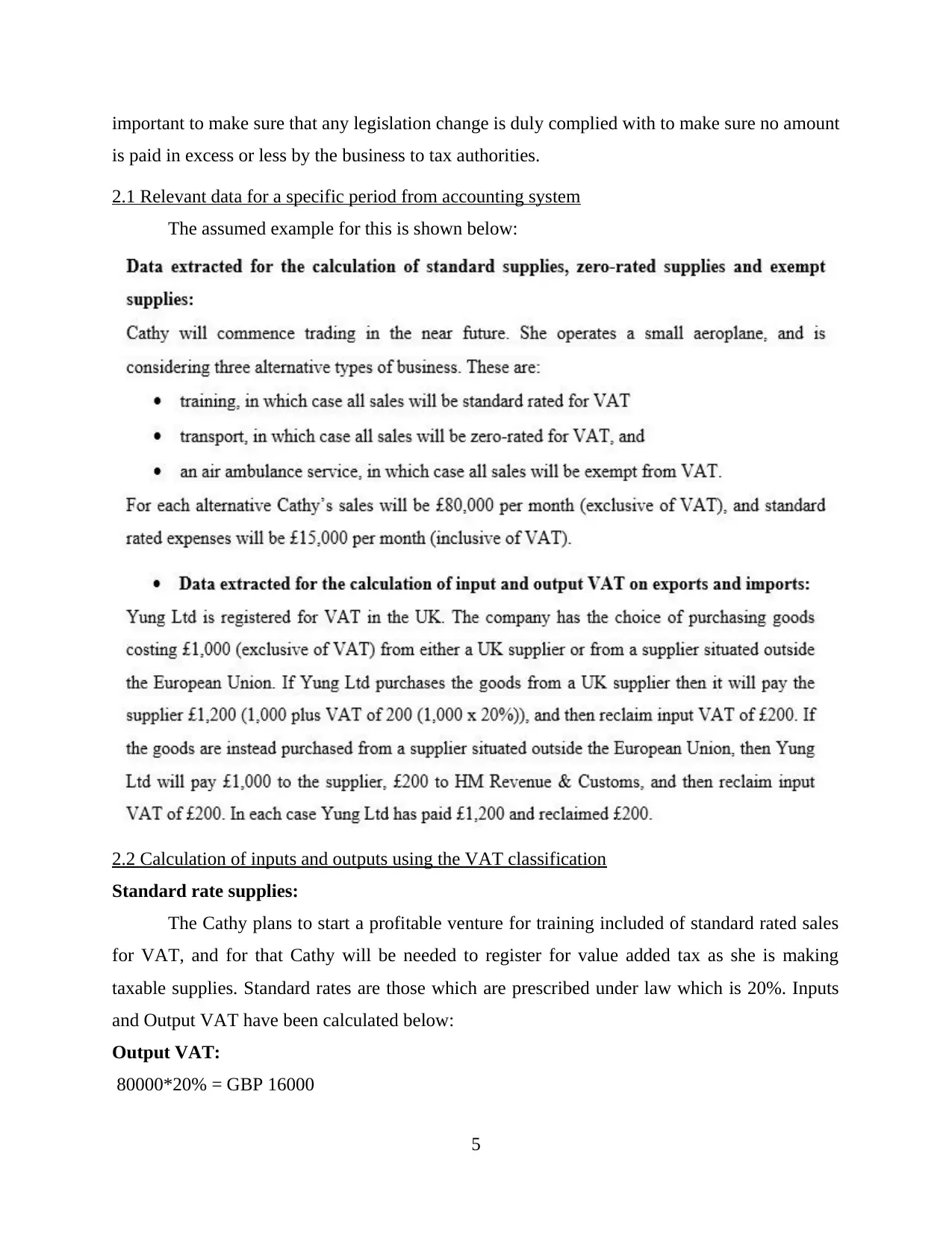
important to make sure that any legislation change is duly complied with to make sure no amount
is paid in excess or less by the business to tax authorities.
2.1 Relevant data for a specific period from accounting system
The assumed example for this is shown below:
2.2 Calculation of inputs and outputs using the VAT classification
Standard rate supplies:
The Cathy plans to start a profitable venture for training included of standard rated sales
for VAT, and for that Cathy will be needed to register for value added tax as she is making
taxable supplies. Standard rates are those which are prescribed under law which is 20%. Inputs
and Output VAT have been calculated below:
Output VAT:
80000*20% = GBP 16000
5
is paid in excess or less by the business to tax authorities.
2.1 Relevant data for a specific period from accounting system
The assumed example for this is shown below:
2.2 Calculation of inputs and outputs using the VAT classification
Standard rate supplies:
The Cathy plans to start a profitable venture for training included of standard rated sales
for VAT, and for that Cathy will be needed to register for value added tax as she is making
taxable supplies. Standard rates are those which are prescribed under law which is 20%. Inputs
and Output VAT have been calculated below:
Output VAT:
80000*20% = GBP 16000
5
Paraphrase This Document
Need a fresh take? Get an instant paraphrase of this document with our AI Paraphraser
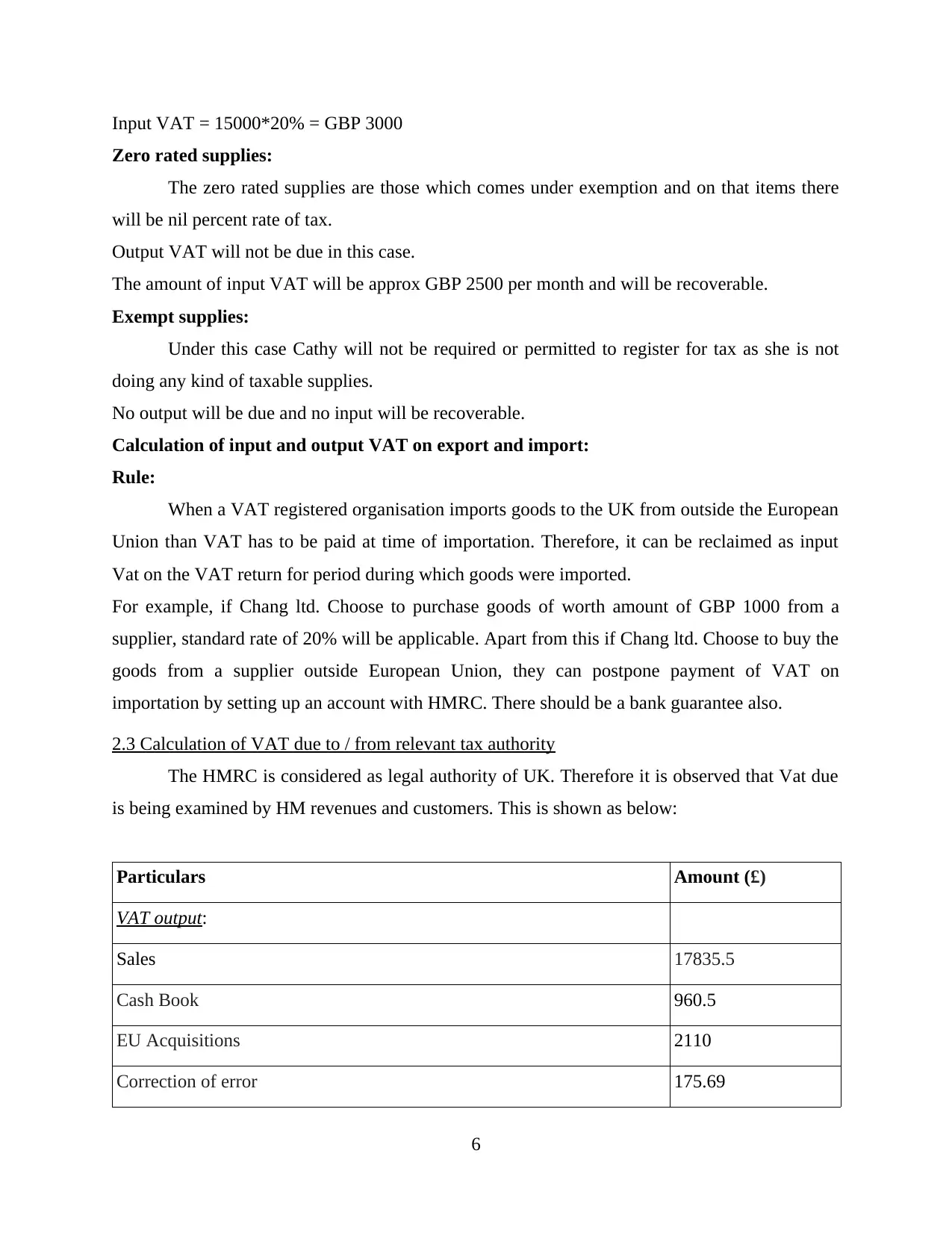
Input VAT = 15000*20% = GBP 3000
Zero rated supplies:
The zero rated supplies are those which comes under exemption and on that items there
will be nil percent rate of tax.
Output VAT will not be due in this case.
The amount of input VAT will be approx GBP 2500 per month and will be recoverable.
Exempt supplies:
Under this case Cathy will not be required or permitted to register for tax as she is not
doing any kind of taxable supplies.
No output will be due and no input will be recoverable.
Calculation of input and output VAT on export and import:
Rule:
When a VAT registered organisation imports goods to the UK from outside the European
Union than VAT has to be paid at time of importation. Therefore, it can be reclaimed as input
Vat on the VAT return for period during which goods were imported.
For example, if Chang ltd. Choose to purchase goods of worth amount of GBP 1000 from a
supplier, standard rate of 20% will be applicable. Apart from this if Chang ltd. Choose to buy the
goods from a supplier outside European Union, they can postpone payment of VAT on
importation by setting up an account with HMRC. There should be a bank guarantee also.
2.3 Calculation of VAT due to / from relevant tax authority
The HMRC is considered as legal authority of UK. Therefore it is observed that Vat due
is being examined by HM revenues and customers. This is shown as below:
Particulars Amount (£)
VAT output:
Sales 17835.5
Cash Book 960.5
EU Acquisitions 2110
Correction of error 175.69
6
Zero rated supplies:
The zero rated supplies are those which comes under exemption and on that items there
will be nil percent rate of tax.
Output VAT will not be due in this case.
The amount of input VAT will be approx GBP 2500 per month and will be recoverable.
Exempt supplies:
Under this case Cathy will not be required or permitted to register for tax as she is not
doing any kind of taxable supplies.
No output will be due and no input will be recoverable.
Calculation of input and output VAT on export and import:
Rule:
When a VAT registered organisation imports goods to the UK from outside the European
Union than VAT has to be paid at time of importation. Therefore, it can be reclaimed as input
Vat on the VAT return for period during which goods were imported.
For example, if Chang ltd. Choose to purchase goods of worth amount of GBP 1000 from a
supplier, standard rate of 20% will be applicable. Apart from this if Chang ltd. Choose to buy the
goods from a supplier outside European Union, they can postpone payment of VAT on
importation by setting up an account with HMRC. There should be a bank guarantee also.
2.3 Calculation of VAT due to / from relevant tax authority
The HMRC is considered as legal authority of UK. Therefore it is observed that Vat due
is being examined by HM revenues and customers. This is shown as below:
Particulars Amount (£)
VAT output:
Sales 17835.5
Cash Book 960.5
EU Acquisitions 2110
Correction of error 175.69
6
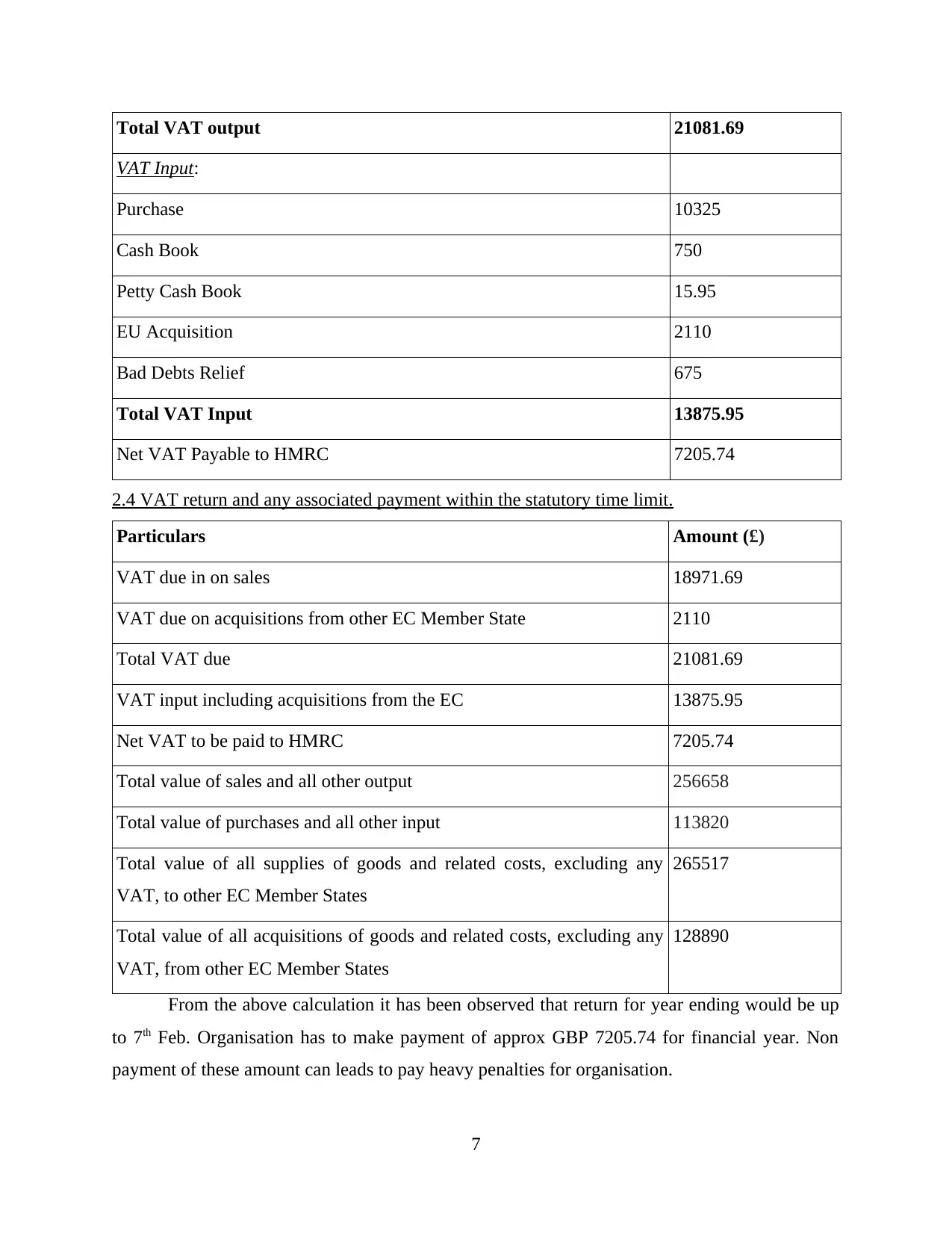
Total VAT output 21081.69
VAT Input:
Purchase 10325
Cash Book 750
Petty Cash Book 15.95
EU Acquisition 2110
Bad Debts Relief 675
Total VAT Input 13875.95
Net VAT Payable to HMRC 7205.74
2.4 VAT return and any associated payment within the statutory time limit.
Particulars Amount (£)
VAT due in on sales 18971.69
VAT due on acquisitions from other EC Member State 2110
Total VAT due 21081.69
VAT input including acquisitions from the EC 13875.95
Net VAT to be paid to HMRC 7205.74
Total value of sales and all other output 256658
Total value of purchases and all other input 113820
Total value of all supplies of goods and related costs, excluding any
VAT, to other EC Member States
265517
Total value of all acquisitions of goods and related costs, excluding any
VAT, from other EC Member States
128890
From the above calculation it has been observed that return for year ending would be up
to 7th Feb. Organisation has to make payment of approx GBP 7205.74 for financial year. Non
payment of these amount can leads to pay heavy penalties for organisation.
7
VAT Input:
Purchase 10325
Cash Book 750
Petty Cash Book 15.95
EU Acquisition 2110
Bad Debts Relief 675
Total VAT Input 13875.95
Net VAT Payable to HMRC 7205.74
2.4 VAT return and any associated payment within the statutory time limit.
Particulars Amount (£)
VAT due in on sales 18971.69
VAT due on acquisitions from other EC Member State 2110
Total VAT due 21081.69
VAT input including acquisitions from the EC 13875.95
Net VAT to be paid to HMRC 7205.74
Total value of sales and all other output 256658
Total value of purchases and all other input 113820
Total value of all supplies of goods and related costs, excluding any
VAT, to other EC Member States
265517
Total value of all acquisitions of goods and related costs, excluding any
VAT, from other EC Member States
128890
From the above calculation it has been observed that return for year ending would be up
to 7th Feb. Organisation has to make payment of approx GBP 7205.74 for financial year. Non
payment of these amount can leads to pay heavy penalties for organisation.
7
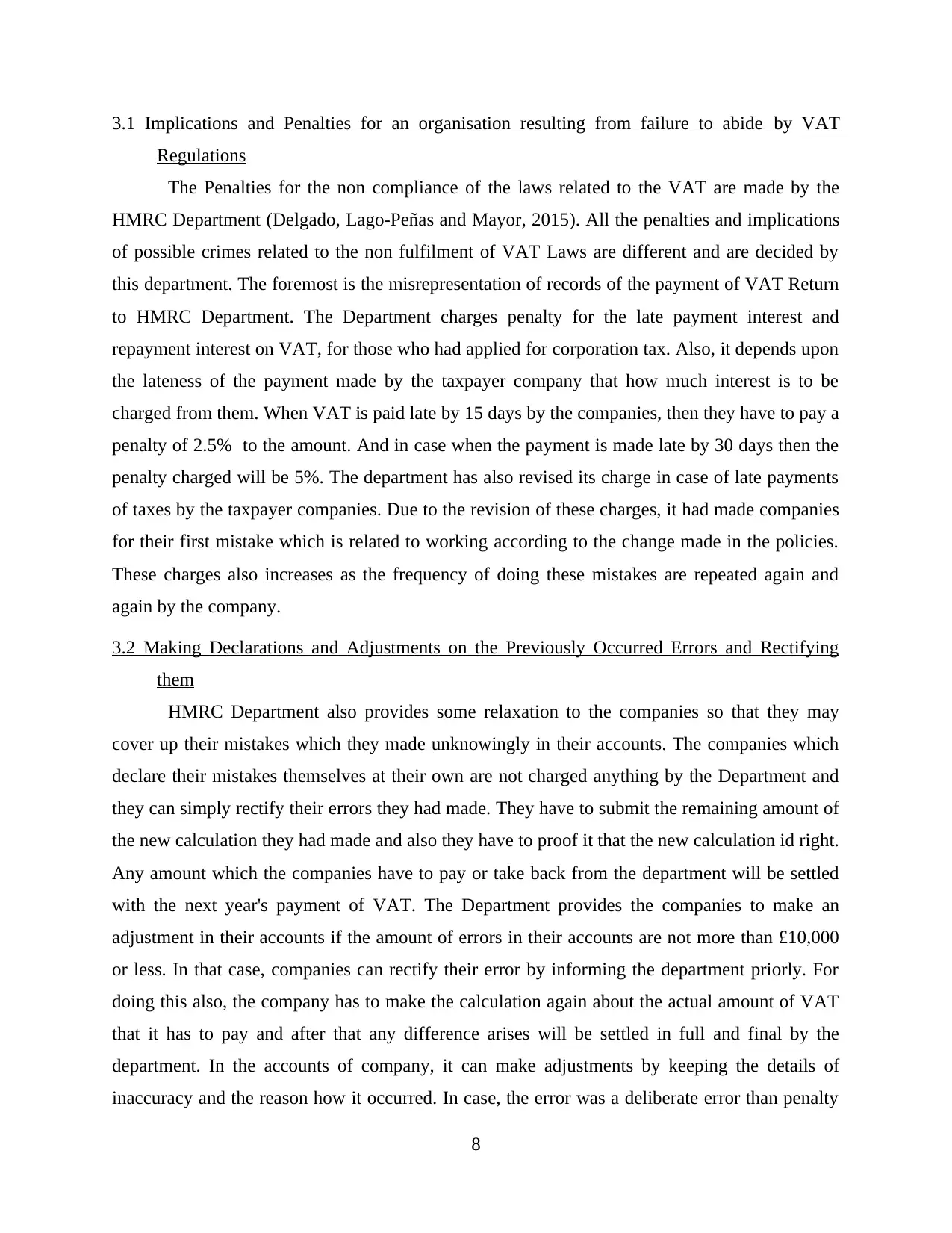
3.1 Implications and Penalties for an organisation resulting from failure to abide by VAT
Regulations
The Penalties for the non compliance of the laws related to the VAT are made by the
HMRC Department (Delgado, Lago‐Peñas and Mayor, 2015). All the penalties and implications
of possible crimes related to the non fulfilment of VAT Laws are different and are decided by
this department. The foremost is the misrepresentation of records of the payment of VAT Return
to HMRC Department. The Department charges penalty for the late payment interest and
repayment interest on VAT, for those who had applied for corporation tax. Also, it depends upon
the lateness of the payment made by the taxpayer company that how much interest is to be
charged from them. When VAT is paid late by 15 days by the companies, then they have to pay a
penalty of 2.5% to the amount. And in case when the payment is made late by 30 days then the
penalty charged will be 5%. The department has also revised its charge in case of late payments
of taxes by the taxpayer companies. Due to the revision of these charges, it had made companies
for their first mistake which is related to working according to the change made in the policies.
These charges also increases as the frequency of doing these mistakes are repeated again and
again by the company.
3.2 Making Declarations and Adjustments on the Previously Occurred Errors and Rectifying
them
HMRC Department also provides some relaxation to the companies so that they may
cover up their mistakes which they made unknowingly in their accounts. The companies which
declare their mistakes themselves at their own are not charged anything by the Department and
they can simply rectify their errors they had made. They have to submit the remaining amount of
the new calculation they had made and also they have to proof it that the new calculation id right.
Any amount which the companies have to pay or take back from the department will be settled
with the next year's payment of VAT. The Department provides the companies to make an
adjustment in their accounts if the amount of errors in their accounts are not more than £10,000
or less. In that case, companies can rectify their error by informing the department priorly. For
doing this also, the company has to make the calculation again about the actual amount of VAT
that it has to pay and after that any difference arises will be settled in full and final by the
department. In the accounts of company, it can make adjustments by keeping the details of
inaccuracy and the reason how it occurred. In case, the error was a deliberate error than penalty
8
Regulations
The Penalties for the non compliance of the laws related to the VAT are made by the
HMRC Department (Delgado, Lago‐Peñas and Mayor, 2015). All the penalties and implications
of possible crimes related to the non fulfilment of VAT Laws are different and are decided by
this department. The foremost is the misrepresentation of records of the payment of VAT Return
to HMRC Department. The Department charges penalty for the late payment interest and
repayment interest on VAT, for those who had applied for corporation tax. Also, it depends upon
the lateness of the payment made by the taxpayer company that how much interest is to be
charged from them. When VAT is paid late by 15 days by the companies, then they have to pay a
penalty of 2.5% to the amount. And in case when the payment is made late by 30 days then the
penalty charged will be 5%. The department has also revised its charge in case of late payments
of taxes by the taxpayer companies. Due to the revision of these charges, it had made companies
for their first mistake which is related to working according to the change made in the policies.
These charges also increases as the frequency of doing these mistakes are repeated again and
again by the company.
3.2 Making Declarations and Adjustments on the Previously Occurred Errors and Rectifying
them
HMRC Department also provides some relaxation to the companies so that they may
cover up their mistakes which they made unknowingly in their accounts. The companies which
declare their mistakes themselves at their own are not charged anything by the Department and
they can simply rectify their errors they had made. They have to submit the remaining amount of
the new calculation they had made and also they have to proof it that the new calculation id right.
Any amount which the companies have to pay or take back from the department will be settled
with the next year's payment of VAT. The Department provides the companies to make an
adjustment in their accounts if the amount of errors in their accounts are not more than £10,000
or less. In that case, companies can rectify their error by informing the department priorly. For
doing this also, the company has to make the calculation again about the actual amount of VAT
that it has to pay and after that any difference arises will be settled in full and final by the
department. In the accounts of company, it can make adjustments by keeping the details of
inaccuracy and the reason how it occurred. In case, the error was a deliberate error than penalty
8
Secure Best Marks with AI Grader
Need help grading? Try our AI Grader for instant feedback on your assignments.
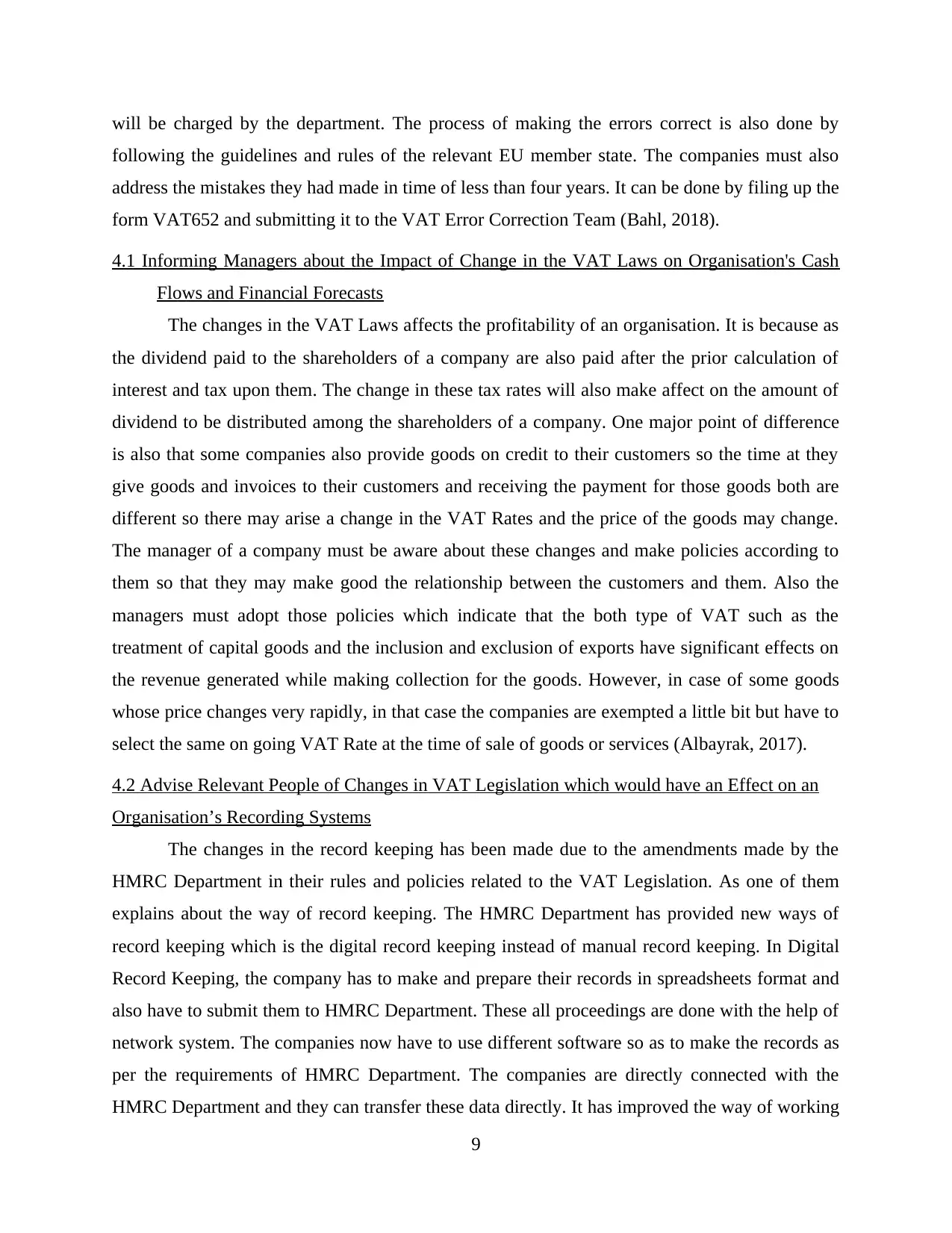
will be charged by the department. The process of making the errors correct is also done by
following the guidelines and rules of the relevant EU member state. The companies must also
address the mistakes they had made in time of less than four years. It can be done by filing up the
form VAT652 and submitting it to the VAT Error Correction Team (Bahl, 2018).
4.1 Informing Managers about the Impact of Change in the VAT Laws on Organisation's Cash
Flows and Financial Forecasts
The changes in the VAT Laws affects the profitability of an organisation. It is because as
the dividend paid to the shareholders of a company are also paid after the prior calculation of
interest and tax upon them. The change in these tax rates will also make affect on the amount of
dividend to be distributed among the shareholders of a company. One major point of difference
is also that some companies also provide goods on credit to their customers so the time at they
give goods and invoices to their customers and receiving the payment for those goods both are
different so there may arise a change in the VAT Rates and the price of the goods may change.
The manager of a company must be aware about these changes and make policies according to
them so that they may make good the relationship between the customers and them. Also the
managers must adopt those policies which indicate that the both type of VAT such as the
treatment of capital goods and the inclusion and exclusion of exports have significant effects on
the revenue generated while making collection for the goods. However, in case of some goods
whose price changes very rapidly, in that case the companies are exempted a little bit but have to
select the same on going VAT Rate at the time of sale of goods or services (Albayrak, 2017).
4.2 Advise Relevant People of Changes in VAT Legislation which would have an Effect on an
Organisation’s Recording Systems
The changes in the record keeping has been made due to the amendments made by the
HMRC Department in their rules and policies related to the VAT Legislation. As one of them
explains about the way of record keeping. The HMRC Department has provided new ways of
record keeping which is the digital record keeping instead of manual record keeping. In Digital
Record Keeping, the company has to make and prepare their records in spreadsheets format and
also have to submit them to HMRC Department. These all proceedings are done with the help of
network system. The companies now have to use different software so as to make the records as
per the requirements of HMRC Department. The companies are directly connected with the
HMRC Department and they can transfer these data directly. It has improved the way of working
9
following the guidelines and rules of the relevant EU member state. The companies must also
address the mistakes they had made in time of less than four years. It can be done by filing up the
form VAT652 and submitting it to the VAT Error Correction Team (Bahl, 2018).
4.1 Informing Managers about the Impact of Change in the VAT Laws on Organisation's Cash
Flows and Financial Forecasts
The changes in the VAT Laws affects the profitability of an organisation. It is because as
the dividend paid to the shareholders of a company are also paid after the prior calculation of
interest and tax upon them. The change in these tax rates will also make affect on the amount of
dividend to be distributed among the shareholders of a company. One major point of difference
is also that some companies also provide goods on credit to their customers so the time at they
give goods and invoices to their customers and receiving the payment for those goods both are
different so there may arise a change in the VAT Rates and the price of the goods may change.
The manager of a company must be aware about these changes and make policies according to
them so that they may make good the relationship between the customers and them. Also the
managers must adopt those policies which indicate that the both type of VAT such as the
treatment of capital goods and the inclusion and exclusion of exports have significant effects on
the revenue generated while making collection for the goods. However, in case of some goods
whose price changes very rapidly, in that case the companies are exempted a little bit but have to
select the same on going VAT Rate at the time of sale of goods or services (Albayrak, 2017).
4.2 Advise Relevant People of Changes in VAT Legislation which would have an Effect on an
Organisation’s Recording Systems
The changes in the record keeping has been made due to the amendments made by the
HMRC Department in their rules and policies related to the VAT Legislation. As one of them
explains about the way of record keeping. The HMRC Department has provided new ways of
record keeping which is the digital record keeping instead of manual record keeping. In Digital
Record Keeping, the company has to make and prepare their records in spreadsheets format and
also have to submit them to HMRC Department. These all proceedings are done with the help of
network system. The companies now have to use different software so as to make the records as
per the requirements of HMRC Department. The companies are directly connected with the
HMRC Department and they can transfer these data directly. It has improved the way of working
9
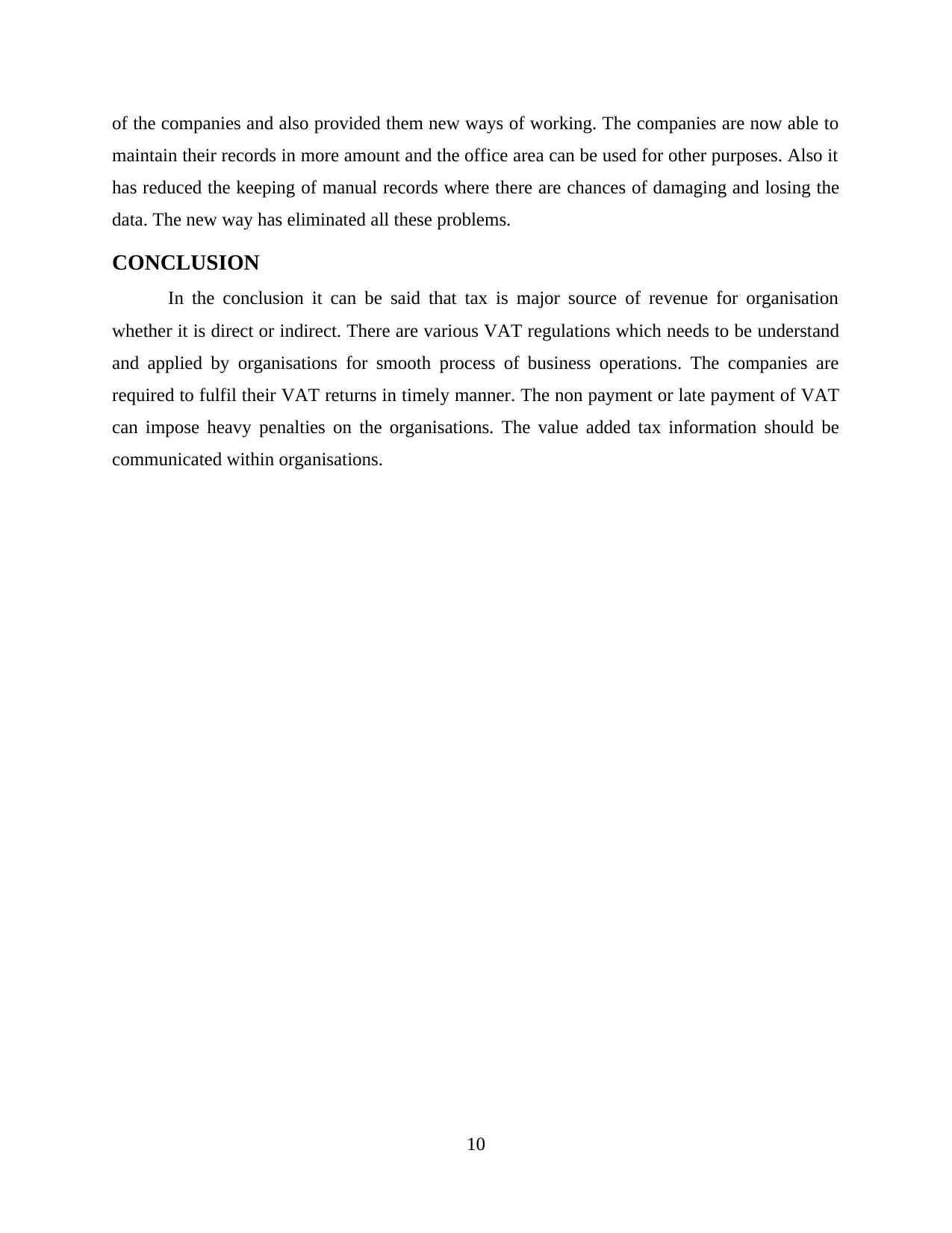
of the companies and also provided them new ways of working. The companies are now able to
maintain their records in more amount and the office area can be used for other purposes. Also it
has reduced the keeping of manual records where there are chances of damaging and losing the
data. The new way has eliminated all these problems.
CONCLUSION
In the conclusion it can be said that tax is major source of revenue for organisation
whether it is direct or indirect. There are various VAT regulations which needs to be understand
and applied by organisations for smooth process of business operations. The companies are
required to fulfil their VAT returns in timely manner. The non payment or late payment of VAT
can impose heavy penalties on the organisations. The value added tax information should be
communicated within organisations.
10
maintain their records in more amount and the office area can be used for other purposes. Also it
has reduced the keeping of manual records where there are chances of damaging and losing the
data. The new way has eliminated all these problems.
CONCLUSION
In the conclusion it can be said that tax is major source of revenue for organisation
whether it is direct or indirect. There are various VAT regulations which needs to be understand
and applied by organisations for smooth process of business operations. The companies are
required to fulfil their VAT returns in timely manner. The non payment or late payment of VAT
can impose heavy penalties on the organisations. The value added tax information should be
communicated within organisations.
10
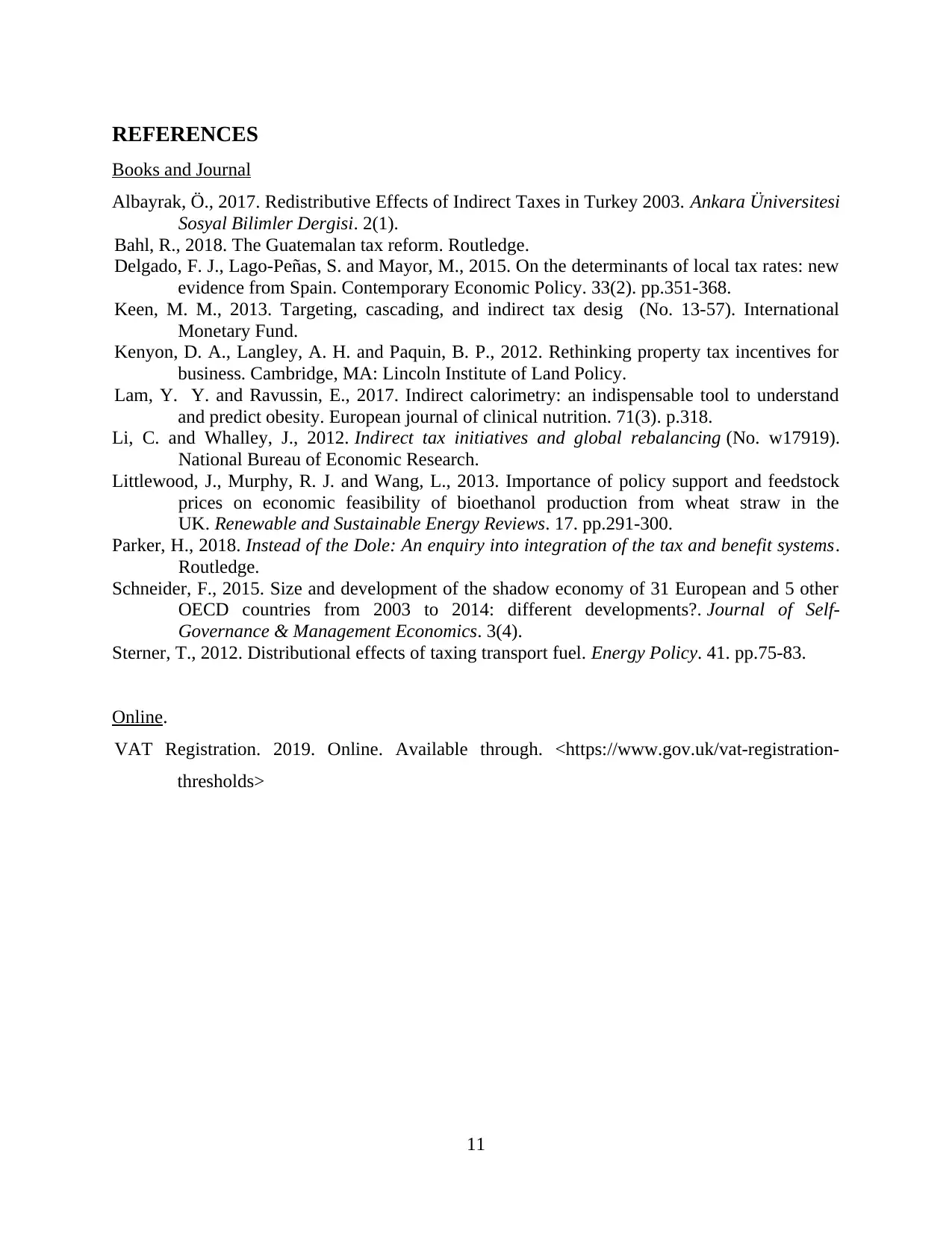
REFERENCES
Books and Journal
Albayrak, Ö., 2017. Redistributive Effects of Indirect Taxes in Turkey 2003. Ankara Üniversitesi
Sosyal Bilimler Dergisi. 2(1).
Bahl, R., 2018. The Guatemalan tax reform. Routledge.
Delgado, F. J., Lago‐Peñas, S. and Mayor, M., 2015. On the determinants of local tax rates: new
evidence from Spain. Contemporary Economic Policy. 33(2). pp.351-368.
Keen, M. M., 2013. Targeting, cascading, and indirect tax desig (No. 13-57). International
Monetary Fund.
Kenyon, D. A., Langley, A. H. and Paquin, B. P., 2012. Rethinking property tax incentives for
business. Cambridge, MA: Lincoln Institute of Land Policy.
Lam, Y. Y. and Ravussin, E., 2017. Indirect calorimetry: an indispensable tool to understand
and predict obesity. European journal of clinical nutrition. 71(3). p.318.
Li, C. and Whalley, J., 2012. Indirect tax initiatives and global rebalancing (No. w17919).
National Bureau of Economic Research.
Littlewood, J., Murphy, R. J. and Wang, L., 2013. Importance of policy support and feedstock
prices on economic feasibility of bioethanol production from wheat straw in the
UK. Renewable and Sustainable Energy Reviews. 17. pp.291-300.
Parker, H., 2018. Instead of the Dole: An enquiry into integration of the tax and benefit systems.
Routledge.
Schneider, F., 2015. Size and development of the shadow economy of 31 European and 5 other
OECD countries from 2003 to 2014: different developments?. Journal of Self-
Governance & Management Economics. 3(4).
Sterner, T., 2012. Distributional effects of taxing transport fuel. Energy Policy. 41. pp.75-83.
Online.
VAT Registration. 2019. Online. Available through. <https://www.gov.uk/vat-registration-
thresholds>
11
Books and Journal
Albayrak, Ö., 2017. Redistributive Effects of Indirect Taxes in Turkey 2003. Ankara Üniversitesi
Sosyal Bilimler Dergisi. 2(1).
Bahl, R., 2018. The Guatemalan tax reform. Routledge.
Delgado, F. J., Lago‐Peñas, S. and Mayor, M., 2015. On the determinants of local tax rates: new
evidence from Spain. Contemporary Economic Policy. 33(2). pp.351-368.
Keen, M. M., 2013. Targeting, cascading, and indirect tax desig (No. 13-57). International
Monetary Fund.
Kenyon, D. A., Langley, A. H. and Paquin, B. P., 2012. Rethinking property tax incentives for
business. Cambridge, MA: Lincoln Institute of Land Policy.
Lam, Y. Y. and Ravussin, E., 2017. Indirect calorimetry: an indispensable tool to understand
and predict obesity. European journal of clinical nutrition. 71(3). p.318.
Li, C. and Whalley, J., 2012. Indirect tax initiatives and global rebalancing (No. w17919).
National Bureau of Economic Research.
Littlewood, J., Murphy, R. J. and Wang, L., 2013. Importance of policy support and feedstock
prices on economic feasibility of bioethanol production from wheat straw in the
UK. Renewable and Sustainable Energy Reviews. 17. pp.291-300.
Parker, H., 2018. Instead of the Dole: An enquiry into integration of the tax and benefit systems.
Routledge.
Schneider, F., 2015. Size and development of the shadow economy of 31 European and 5 other
OECD countries from 2003 to 2014: different developments?. Journal of Self-
Governance & Management Economics. 3(4).
Sterner, T., 2012. Distributional effects of taxing transport fuel. Energy Policy. 41. pp.75-83.
Online.
VAT Registration. 2019. Online. Available through. <https://www.gov.uk/vat-registration-
thresholds>
11
Paraphrase This Document
Need a fresh take? Get an instant paraphrase of this document with our AI Paraphraser

12
1 out of 14
Related Documents
Your All-in-One AI-Powered Toolkit for Academic Success.
+13062052269
info@desklib.com
Available 24*7 on WhatsApp / Email
![[object Object]](/_next/static/media/star-bottom.7253800d.svg)
Unlock your academic potential
© 2024 | Zucol Services PVT LTD | All rights reserved.





